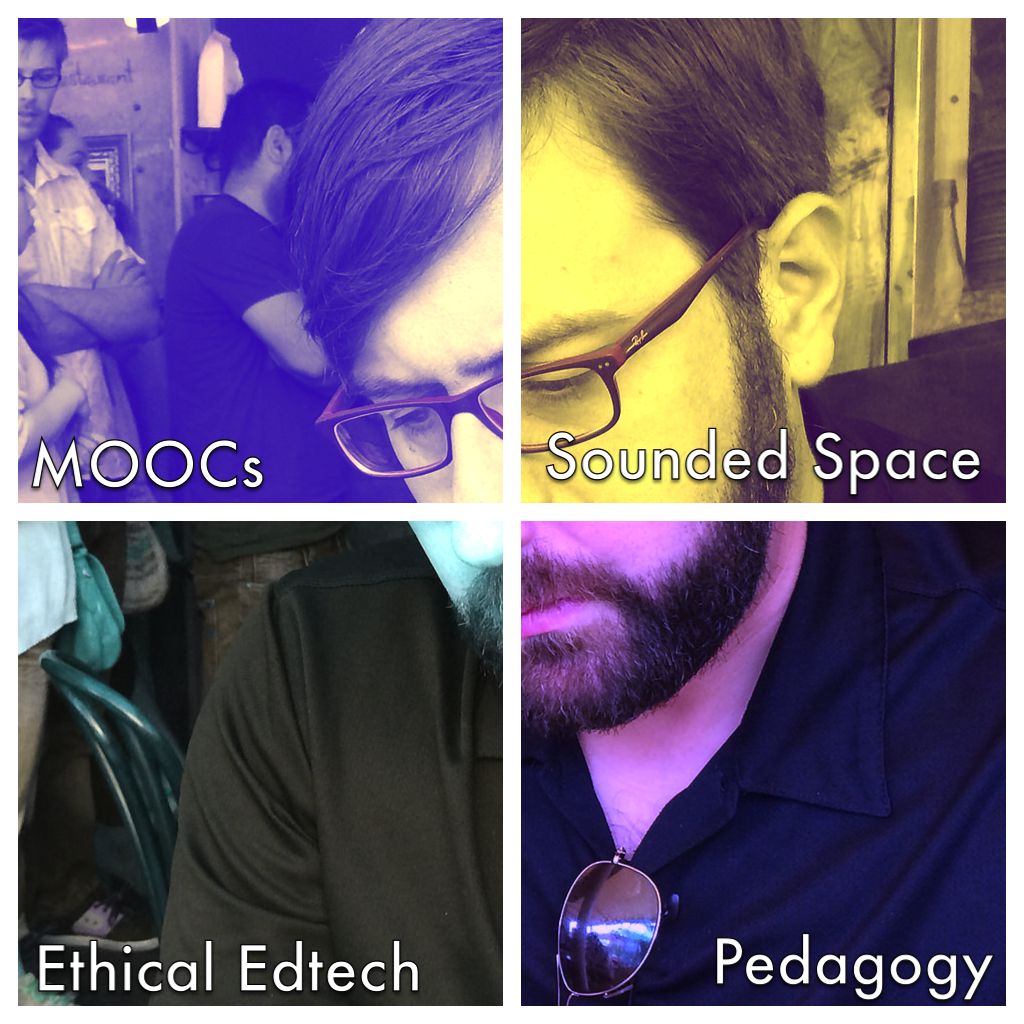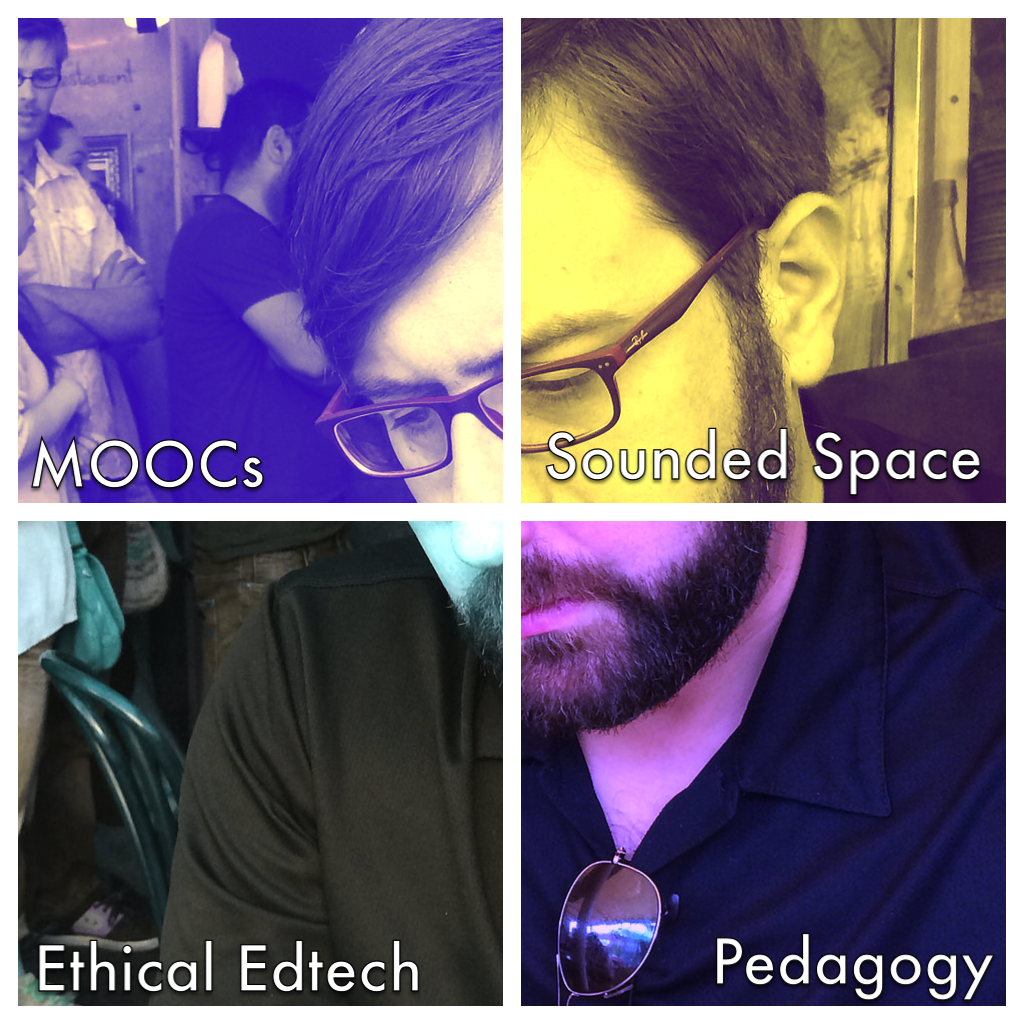I realized that the sheer volume of entries I had on my To Do List in a special section called ‘Writing Ideas’ was actually inhibiting me from writing them, so I decided to approach this slightly differently. As many of these are initial observations and burgeoning ideas, I decided to group them together in a single post.
Sounded Learning
I am writing a book chapter with Sian Bayne and James Lamb on this, so I don’t want to steal any of our own thunder, but it has become apparent the role of sound in learning, both online and otherwise. How online and mobile learners approach space either as something to be appropriated and territorialized, made personal and proprietary, or how they merely align with what exists around them in some meditative immersion. This is most easily approached through a work we have found most useful and adapted for our own research
- Fluegge, E. (2011). The Consideration of Personal Sound Space: Toward a Practical Perspective on Individualized Auditory Experience. Journal of Sonic Studies, 1(1).
In educational research, we often consider the visual space in our learning design: how the chairs or tables or desks are presented and arranged to allow for optimal communication flow. We rarely, if ever, consider the aural space and how learners assimilate or manipulate these spaces, as well as the power relations that lie behind all of that. Consider what the sonic space of a PS (public school) in Brooklyn as compared to one in Oyster Bay. Vastly different sonic terrain partly due to urban/suburban densities, and partly due to socioeconomic capacity for manipulating space. How some of use headphones to study, some layer music through their existing sound space, how others compose in silence (not the default choice). This is especially true of online learners and mobile learners, appropriating domestic and communal spaces for study. Constructing a bounded visual space and an overlapping, liminal sonic one. Together, they constitute learning space. Pekka and I are writing about something nominally similar in our explorations of open space and the processes of alignment and atunement. Long story short, consider how contested and complicated sonic terrain is for learners, both online and off. They are and those perpetual headphones dangling from their ears attest to that. Consider sound in your learning design and don’t assume silence to be the default choice. It isn’t.
MOOCs and Bad Pedagogy
I am not saying anything in the remotest bit original here, but it dawned on me that one of the, perhaps unintentional, effects of the MOOC phenomena is how transparent it has made the issue of pedagogy. Or more specifically, the prevalence of bad pedagogy throughout higher education. I think many of us work in educational spaces, in education departments even, and this most certainly influences our thinking on this matter (rightly so). We view pedagogy, curriculum and learning design as an absolute; we seek formative assessments whenever possible, summative when necessary. We see detailed and timely feedback as a must; transparency and predictability as a foundation for learning.
However, we must also acknowledge that in many departments amongst many faculty there exists very little articulation of good pedagogy. Classes and courses are often tailored to the idiosyncrasies of the individual professor (not a bad thing, necessarily); however, when aggregated, they fracture away from the curricula as a cohesive narrative of learning. It is supposed to be a narrative of learning, something that can be ‘read’ as a process of passage from novice to expert, from amateur to authority. It is laden with power hierarchies, judgments, morals, ethics, and privilege. Yet, fracturing the narrative through bad pedagogy and idiosyncratic course design is merely obfuscating it further, widening that privilege gap. It must mesh, on some level, into a narrative for it be accessible.
This is a natural byproduct, presumably, of an emphasis on research over teaching. This is a process that is made painfully evident in many MOOCs, which seem to be showcases of online learning from another era. We still desperately dangle the hope of automated assessments as measures of learning; we still wonder why they don’t work as well as they might. We pay lip service to socialized learning, yet warden off spaces with no overlap for discussion. We are making evident that pedagogies are uneven, unequal, and often ineffective. This is a positive process, for sure. Pulling back the curtain and introducing some scrutiny is a welcome thing and ultimately might turn into one of the more positive contributions of the MOOC phenomena. Learning is a serious business. Students are savvier in terms of their choices. MOOC students, being predominantly well educated, presumably are more likely to spot bad pedagogy than most. We know a video isn’t a substitute for a discussion. We know a quiz is fine if rote , inert knowledge is the goal. We now know, if ever we didn’t, that the difference between the good schools and the bad is more than mere prestige (I fully suspect some Ivy League universities are running curricula that I might cringe at), more than mere research outputs. Some take teaching very seriously; others don’t. MOOCs are helping bring that to light.
Edtech is ethically contested space
There are many more qualified individuals than me to discuss this, but through my own teaching practice, I am realizing this to be true. Edtech is ethically gray and ambiguous. It is contested, awash with interests and entities with goals that aren’t inherently related to values that we in the education community hold. Trust, socialization, learning, formative development are not, at least not as far as I can see, aligned with market forces. That is fine. I never expected them to be. I don’t think they are evil; that type of talk feels ridiculous to me. They are actors in a larger environment of activity. They are duty bound to their own survival and progress, as are we.
However, when I use WordPress for my own courses (as I did this semester and last), when I develop a workaround to keep the blogs private to only the other students in the course, when I get Buddypress up and running to manage discussion around the writing, when I give them that option to broadcast their writing to the world or to their own peer group, I understand that this is ethically complicated. I am exposing them to this gray space the minute I ask them to create the WordPress blog, the minute they go to the site and enter an email. I am asking them to make a decision regarding the exposure of their writing that I suspect they don’t fully appreciate (I can barely get my head around it). Yet ask them I do. I just inject reflection into the mix to make sure they are aware of what they are doing. At the end of the semester, I encourage them to keep writing on the blog or delete it altogether. To come down one way or the other on their participation in this space. But I know it is contested and, at times, ethically suspect to even have them in there in the first place. It is an assessed risk, as I see it, but it is a risk. It commodifies them, this participation. It makes them a metric. It further leans the market towards commodified ‘solutions’: automated assessment mechanisms, learning analytics (not all of it, but some of it certainly), micro-credentialing, even MOOCs to some degree. I am a part of that. I acknowledge that and seek to minimize the risk. But participate we shall, despite all of this.
I think a decent analogy is that of fair use or fair dealings. I did a lesson in class where we considered fair use as it applied to what we were doing with our final projects; we discussed some individual cases (the Lessig vs. the record company one is instructive), broadened it out to a larger appreciation of copyright law (and copyleft, Creative Commons, etc.). We then began discussing their final projects and how they included materials that would have been protected by copyright, if we hadn’t been nominally protected through the education clause of fair use. We discussed where they are, the actual final projects. How they were submitted to me via email. How they now existed on both our laptops, both our email applications, my Dropbox. How one act of sharing led to five different copies of the work. The use of educational technology is like this. It is a diffusion, like dye cast in water. Participation is difficult, if not possible, to retrieve online. Learning is an aggregation of multiple acts of participation, all of it traceable and marketable. I initiated that, as a teacher.
I don’t have a solution here, or some larger lesson. I just want to acknowledge that my pedagogy inherently introduces this risk. That it inherently becomes an ethically contested space. Learning remains an act of courage, especially online.

